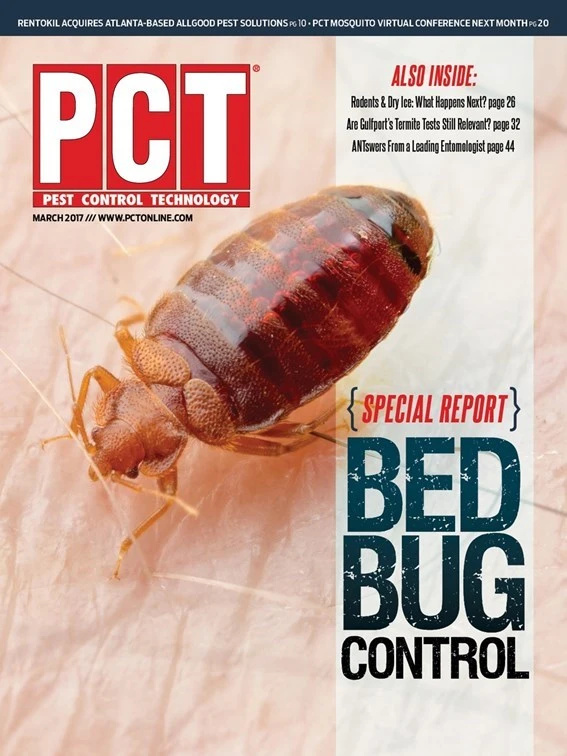
The sight of even one bed bug crossing a mattress or climbing on a bed frame can set off major alarm bells for clients. And can you blame them? The stigmas attached to bed bugs are enough to make people throw out perfectly good furniture, discard clothes by the bagful and spend thousands of dollars on a variety of treatment regimens. The bottom line is no one wants bed bugs.
But what if your inspector or technician spots just one or two of these nasty, blood-sucking little critters? Is it a sign of a much larger infestation or is it simply just a few isolated bed bugs?
LOCATION, LOCATION, LOCATION. Mark Sheperdigian, B.C.E., vice president of technical services for Rose Pest Solutions in Troy, Mich., says a pest management professional’s reaction will depend on where they find that stray bed bug.
“In public places including schools, public transportation or the waiting room of a doctor’s office, seeing a single bed bug is no cause for panic,” says Sheperdigian. “Bed bugs in these locations are likely brought in inside a backpack or article of clothing in the morning and depart the same way in the afternoon.”
Sheperdigian says bed bugs found in non-hotel commercial accounts do not have access to regular food sources — humans or animals resting for a long period of time — and as a result will have a harder time establishing themselves.
Rick Cooper, Ph.D., vice president/technical director, of Cooper Pest Solutions in Lawrenceville, N.J., agrees discovering one or two bed bugs should not set off a five-alarm alert because lower-level populations have barriers to successfully establishing a full-blown infestation.
“Despite their prolific reproductive capabilities, bed bugs do not always increase in population, especially in small numbers where a fertilized female may not be present,” says Cooper. “There is always the possibility there are more but the same aggressive treatment actions required for an established infestation do not need to be taken."
THE SOURCE? No matter the type of account or number of bed bugs found, the curious bed bug inspector needs to determine the likelihood if the bed bug was simply “dropped off” or if there is a more significant infestation of breeding adult bed bugs lurking nearby.
“The technician or inspector must identify where bed bugs are most likely to hide in the account and conduct a thorough inspection using a combination of human and canine inspectors,” says Sheperdigian.
Another method to determine the severity of a bed bug infestation is by establishing a monitoring program using interceptors. When placed strategically in the corner of a room or under legs of furniture, interceptors will help PMPs gauge the severity and activity level of a possible infestation.
If a small number of bed bugs are found in a single-family home, inspectors and technicians stand a better chance of locating the source of the infestation because potential “hot spot” areas (i.e., where people rest for extended periods of time) are clearer and the method of introduction was likely a piece of luggage or furniture, a sleeping bag or article of clothing.
In apartments and condominiums, identifying the source of the infestation is a little trickier because the source of the bed bugs could be the apartment next door, above, below or across the hall. As a result the scope of the inspection and any treatment protocols must be more comprehensive and include the entire building — not just one unit.
When small numbers of bed bugs are found in an account but no “mega infestation” is discovered, pest management professionals can recommend a preventive treatment program to clients. Preventive treatment programs include monitors/interceptors, mattress encasements, active mattress liners and self-help steps including reducing clutter and frequent laundering of clothes and bedding.
The author is an editorial contributor to PCT magazine and a partner at B Communications, Mentor, Ohio.

Explore the March 2017 Issue
Check out more from this issue and find your next story to read.
Latest from Pest Control Technology
- Donny Oswalt Shares What Makes Termites a 'Tricky' Pest
- Study Finds Fecal Tests Can Reveal Active Termite Infestations
- Peachtree Pest Control Partners with Local Nonprofits to Fight Food Insecurity
- Allergy Technologies, PHA Expand ATAHC Complete Program to Protect 8,500 Homes
- Housecall Pro Hosts '25 Winter Summit Featuring Mike Rowe
- Advanced Education
- Spotted Lanternflies, BMSBs Most Problematic Invasive Pests, Poll Finds
- Ecolab Acquires Guardian Pest Solutions





